First Motion - Demystifying Quantum Mechanics. This is My Video Lecture Script for First Motion and The Static Matter Theory
Post Date: August 27, 2025
Completed Video Lecture - August 2025 - LINK TO VIDEO
Hi, I'm C. Dean Caskey, you can call me C. I have a degree in philosophy, but I've spent the last five years studying problems between general relativity and quantum mechanics.
-- And I would like to introduce the Static Matter Theory and the Principle of First Motion, which helped me develop a logical mechanism that explains how material reality can be static even though it appears to move. My theory also explains why matter and energy appear to be quantized, as in, it appears to be broken into measurable pieces.
-- By a different process, Einstein developed a similar idea in his Static Universe Theory, but the apparent "blunder" with the Cosmological Constant caused him to abandon it.
-- The blunder was caused by Quantum field theory predicting a vast amount of energy in the vacuum of space which greatly exceeds what cosmological observations say it should be. Einstein called it his greatest blunder. But you can't blame him. How does empty space have so much energy in it? That's a big contradiction, it's also another manifestation of the particle duality problem. My theory explains why it all happens. Be warned, you do need a foundation in physics and basic logic to understand this explanation.
-- The actual problem with Einstein's Static Universe Theory is it assumes space and time are infinite. Space and Time are finite products of our conscious perception, which quantizes energy so we can comprehend it. My theory differentiates these elements to explains the contradictions.
-- I used fundamental principles in physics and logic to develop my theory, but what started this obsession was I wanted to understand the concept of infinity, and it turned our to be the key to understanding quantum mechanics. The ancient Greek philosopher Anaximander said infinity has no beginning and no end. It has no measurable boundaries.
-- That's an incredible concept. Why do I call it a concept? Because infinity cannot be physically measured. It's not an object. It's beyond our comprehension. Infinity doesn't fit inside our thoughts or inside our lifetime. There is nothing I can physically show you that represents infinity in its entirety, yet we use the concept like it's a real thing. That causes problems in logic, math, and physics.
-- Currently, the biggest mystery in physics is our inability to explain how gravity works between general relativity and quantum mechanics. Those are the two big theories of modern physics, and they don't fundamentally connect, and here is why.
-- General relativity deals with measurable objects that we can directly perceive with our bodily senses. Quantum mechanics deals with immeasurable concepts that we cannot directly perceive. Objects and concepts are opposites. You can't mix them together without contradictions. Before you jump to a conclusion about that statement, let me explain the evidence behind it.
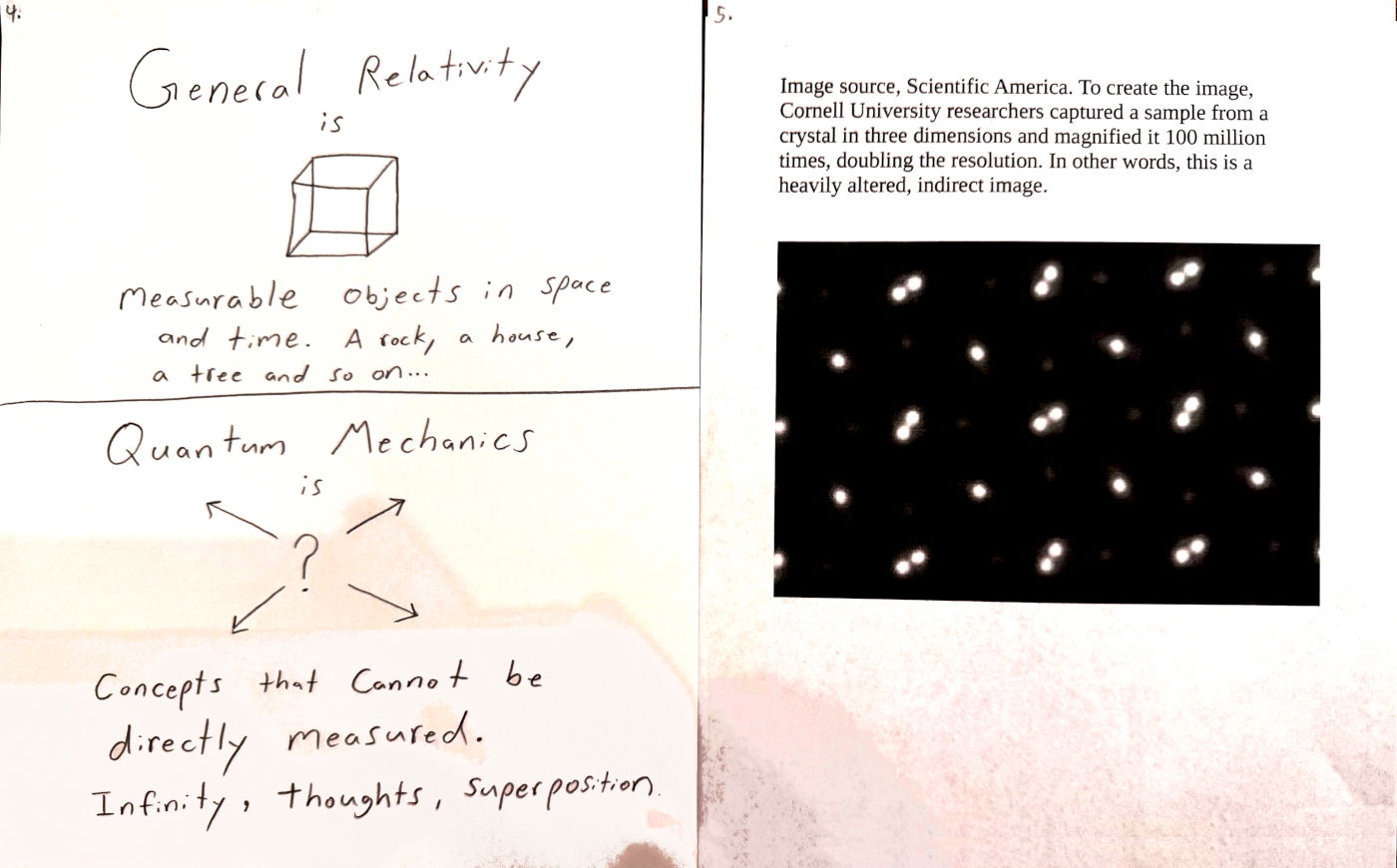
-- Wave-particle duality is a founding principle of quantum mechanics and it's one big contradiction. Particle duality is the assumption that atomic particles behave like measurable objects and immeasurable waves at the same time. Something cannot be two fundamentally different things at once. Something else is going on. The contradiction needs to be explained, not used as a founding principle. Remember, I'm not saying the equations that explain quantum mechanics are wrong. I'm saying we're interpreting them from the wrong perspective, and understanding infinity is the key clarifying it.
-- So, let's clearly define infinity since it's a difficult concept to grasp... mostly because it's been used incorrectly for over a hundred years. According to Merriam-Webster online dictionary; something Infinite extends indefinitely: it's endless; It's subject to no limitation. In other words, infinity has no beginning and no end, thus is cannot be created or destroyed. Infinity doesn't change and it's outside of time. Not changing is a direct result of having no measurable coordinates in space and time. Why is that? It's because infinity is the sum of all possible coordinates in space and time. That means infinity is the past, present, future and all possible things together all at once. Infinity is a complete picture of reality or the sum of all things. That fundamental premise is often misconstrued in physics.
-- In other words, you CANNOT keep pretending to measure something that cannot be measured. Concepts cannot be measured. You can't break infinity in half or measure it in quarters. It doesn't work that way. Once you give infinity a measurable boundary, it's no longer infinity. This is basic logic. Infinity exists as a concept because it has no measurable boundaries. Objects and concepts are opposites. General relativity deals with objects in space and time, quantum mechanics deals with concept outside of space and time. And yes, I know particles can be measured with probabilities. That supports my point because using probabilities is an indirect way of measuring something.
-- So, yes, I think atoms and their particles are infinite and outside of space and time. How can I say such a thing? We can't actually see atoms with our eyes, but thanks to advanced instruments and experimentation, we discovered many possible attributes of atoms, and the research is so consistent, we now have the laws of conservation of mass and energy that say atoms cannot be created or destroyed. This principle is concrete, it was centuries in the making, and it was finalized with the principle of mass–energy equivalence described by Albert Einstein's equation E=Mc2.
-- For a simpler explanation, atoms have no beginning and no end, they cannot be created or destroyed, they can't be directly measured, and they are outside of time. Something outside of space and time doesn't change because it is the sum of all possible changes. It's a completed picture of reality.
-- By the way, if someone claims to have a photograph of an atom, it was not taken directly. It was generated by algorithms from an advanced electron microscope. It's an indirect way of building an image. Like this image I sourced from, Scientific America.com. [I'm showing a generated picture of atoms at this point.] To create the image, Cornell University researchers captured a sample from a crystal in three dimensions and magnified it 100 million times, doubling the resolution. In other words, this is a heavily altered, indirect image on an atom. -- (In reference to the second image from above^)
-- But, thanks to indirect observations, we know atoms appear to change form in chemical reactions and nuclear reactions. Despite the apparent change in form, no energy or mass is lost in the system.
-- So, how does something change and stay the same at the same time? It doesn't. That's another contradiction. It's part of the particle duality problem that I'm going to explain, but first, to understand my theory, you have to assume atoms are infinite, exist outside of time and space, and they don't move. Now, the next big question is, if atoms don't move, how am I experiencing motion and time? Something besides atoms must be causing the motion.
-- So, the big problem with particle duality starts with the assumption that particles are actually moving. Something is moving in reality, but it's not the particles themselves. Now I'm going to explain the Static Matter Theory and the Principle of First Motion. With static matter, atoms are not moving. Atomic particles are in infinite arrangements that cannot be disarranged, and they cannot be created or destroyed. They hold their perfect order outside of time, and they hold enough information to create infinite possible realities. Matter is the perfect library of reality. The only thing moving in this reality is the unseen energy that creates times, and I call it First Motion.
-- My theory says motion is fundamentally separated from material reality, as in motion doesn't change static matter. On top of that, matter didn't explode into being. Matter didn't have a beginning or an end, remember? The evidence for that is in the laws of conservation of mass and energy. Thus, motion is coming from something else.
-- How did I identify this mysterious motion? If we're conscious, we're obviously experiencing motion because we're experience time. Time and motion cannot be separated. I'm subject to time because I can remember my past and I can feel the present. I know the floor will likely be there in the future when I take my next step. I have a past, present, and future, in other words, I'm always in motion because of time. Our personal reality is consistent and it can change. Interestingly, I can stop and stand perfectly still for hours, but despite being as still as possible, my consciousness is still moving forward, even when I'm sleeping! I cannot stop my consciousness or the flow of time without dying, and dying only stops it for me. Why is there still motion when my body is standing still? I'm not pushing my own mind forward. I can't control time. Something else is doing it.
-- That's how I came up with the idea of First Motion. Simply put, time is motion. My conscious motion is the first motion I experience in reality, and I have no control over it. The motion that I CAN control is my bodily motion and other objects around me, that's secondary motion. We experience two kinds of motion in our daily lives. The motion of time, and the motion of our bodies. So, where do these different kinds of motion come from if atoms don't actually move? I have to assume there is an unaccounted for source of energy pushing time forward, and I call it First Motion. That is where all motion comes from. That was my profound realization. For quantum mechanics to make logical sense and to get rid of the contradictions, time has to have a force behind it and atoms have to be infinite.
-- The principle of First Motion says time is an unstoppable force. It has energy behind it, and it doesn't originate from material reality. This new principle simplifies how motion and gravity function by giving reality three foundational principles.
-- First, we have an unstoppable force that moves, which is time. Second, we have infinite matter that doesn't move, that atoms, and third, we have an electromagnetic reaction that occurs when the first two forces interact. We exist within in the reaction. We are the stop-and-go in between two opposing forces. It's that simple.
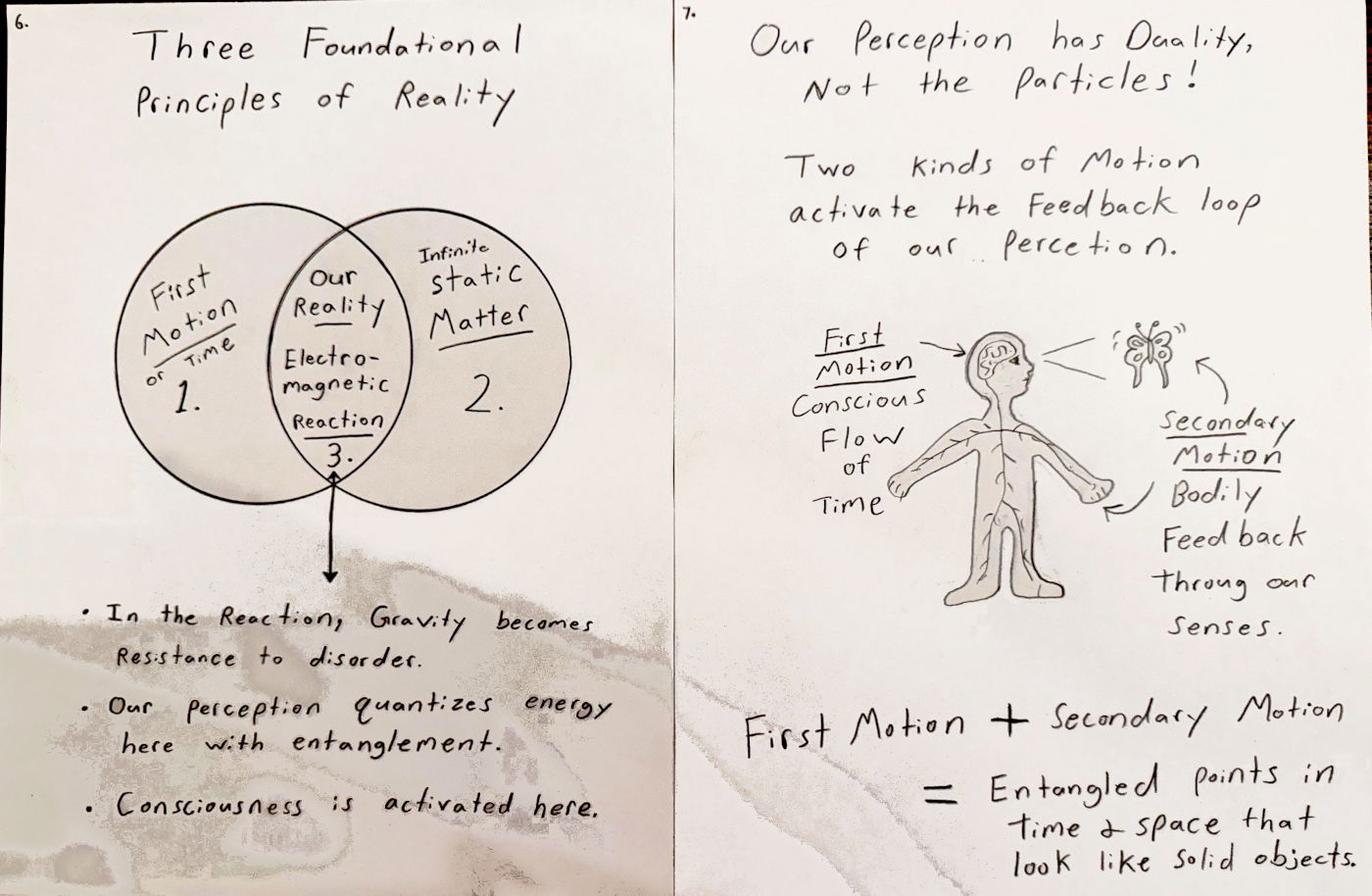
-- By the way, when I say, electromagnetic reaction, I'm using it as a blanket reference for all the fundamental forces because they are all products of First Motion encountering Static Matter. We don't directly perceive either one of those infinite forces. We perceive and exist within the reaction between them. My theory changes the standard model and general relativity by taking into account how we perceive reality. The equations still work, they just need some clarification.
-- So, what we perceive as solid objects, is actually First Motion energy hitting static material that resists the motion, and then the reaction is fed back to us through our central nervous system, which gives the energy measurable points in time and space using entangled pathways. What we see and feel as solid objects is actually entangled energy, and it has a lot force behind it because it's created by two immeasurable opposing forces, one that reacts and one that resists. That also creates heat, which explains black-body radiation and why every physical body spontaneously and continuously emits electromagnetic radiation as long as its temperature is above absolute zero.
-- So, how does infinite-immeasurable matter become quantized and measurable for us? Our central nervous system filters the energetic reaction between infinite motion and matter, and changes is into something we can comprehend. Our central nervous system creates a feedback loop that highlights energy pathways, or points in time and space, which are entangled snap-shots that give objects their dimensions. The steps in the feedback loop quantize energy for us, allowing us to measure it with our senses.
-- First Motion, which is the flow of time that pushes our consciousness forward, and Secondary Motion, which is bodily motion, and it's fed back to us through our central nervous system using out five bodily senses.
-- First Motion + Secondary Motion = Entangled Points in time and space that look like solid objects.
-- What we perceive as a solid object is an area of higher resistance created by entangled energy. We're not seeing particles move, we see energy move in a reaction between two opposing forces, and I discovered evidence for this in the double slit experiment. So let's explain the experiment and the mysteries that it reveals.
-- In Richard Feynman's thought experiments in Volume 3 Chapter 1 of his lectures on physics, he uses examples of bullets, water waves, and electrons to demonstrate different kinds of object motion. It's easy to imagine how singular bullets from a gun will move or how flowing water waves ripple into each other and interfere with each other's momentum.
-- But it's harder to image how electrons behave because we can't directly observe them. So, I would like to focus on the electron experiment since it reveals quantum behavior.
-- To set up the thought experiment, imagine we have an electron gun, a middle wall with two tiny holes in it, and the detector wall at the end. We plan to shoot electrons towards the double slits in the middle wall so they can be measured on the final wall. When the electrons hit the detector wall, we will hear a click from a speaker.
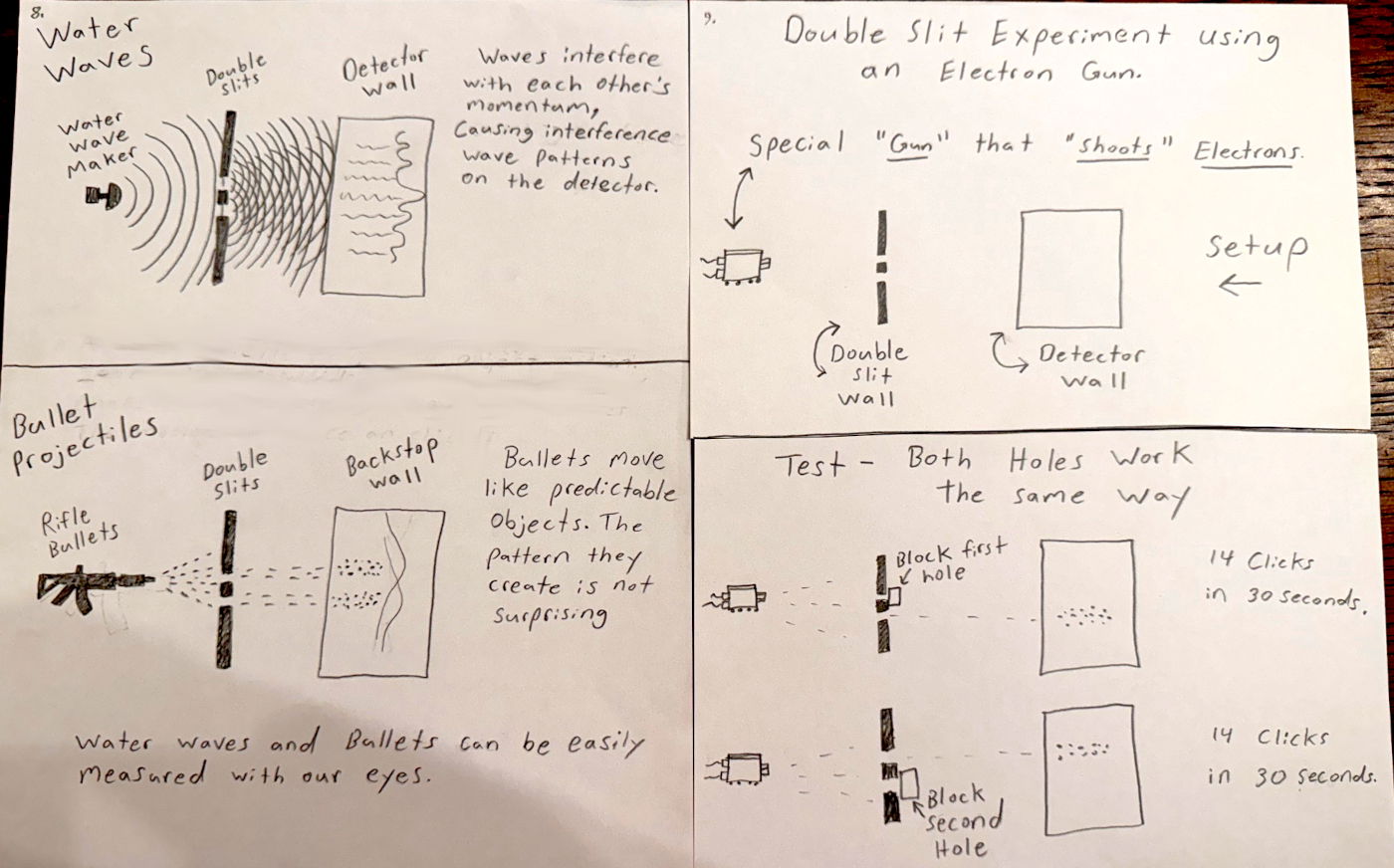
--
But first, to be very thorough, we cover the first slit and measure how many clicks we hear for every electron that passes through it and hits the final wall. The detector makes a single click like the electron arrived in a lump or in a bullet-shaped form. Then we cover the second slit and uncover the first slit and take another reading, roughly the same amount of electrons arrive on the detector wall. No surprises there, both holes work the same way. Now, if the electrons actually behave like bullets, we can simply add these numbers together to predict how many clicks we'll hear when we open both of the slits for the electrons to go through. Surprisingly, that didn't work.
-- When both slits are open and we begin shooting electrons through both holes at the same time, less electrons arrive at the final wall than we originally predicted. That doesn't make sense. They should have shot right through the slits like bullets and added up to a predicable number, but the electrons didn't. What happened? We discovered interference happened when both slits are open like in the water wave experiment!
-- With both slits open, the electrons behave more like waves instead of bullets. Which is really weird considering we're only shooting one electron at a time. How is one electron interfering with itself? It still arrived in a detectable lump according to the click, but after the allotted time, less electrons arrived like it was interfering with itself. It didn't make sense and no one could explain it, so they had to assume that atomic particles behave like waves and bullets, giving them duality. In my theory, we're interpreting the experiment wrong.
-- But first, to further investigate the strange phenomenon, Feynman said we should watch the electrons before they passed through the slits to rule out them taking a strange path. He puts a bright light source between the gun and middle wall, so the electrons will flash some detectable light before they pass through the slits, allowing us to see their path.
-- Surprisingly, once the electrons were under observation, they began behaving like bullets again! No matter what was tried, the bizarre results remained the same. No one couldn't explain why interference happened when the electrons were unobserved, or why they behaved like bullets when they were measured before entering the slits. That's called the mystery of the Observation Effect.
-- But, what he didn't point out, or what he didn't realize at the time, was that measuring the electron gives it a marked position in time and space. A wave function, which is a continues flow, can only be estimated because it doesn't have exact coordinates in time and space, thus it cannot be perceived by our bodily senses. The act of measuring changes the experiment. That means the problem starts with the measuring tools, not the particle.
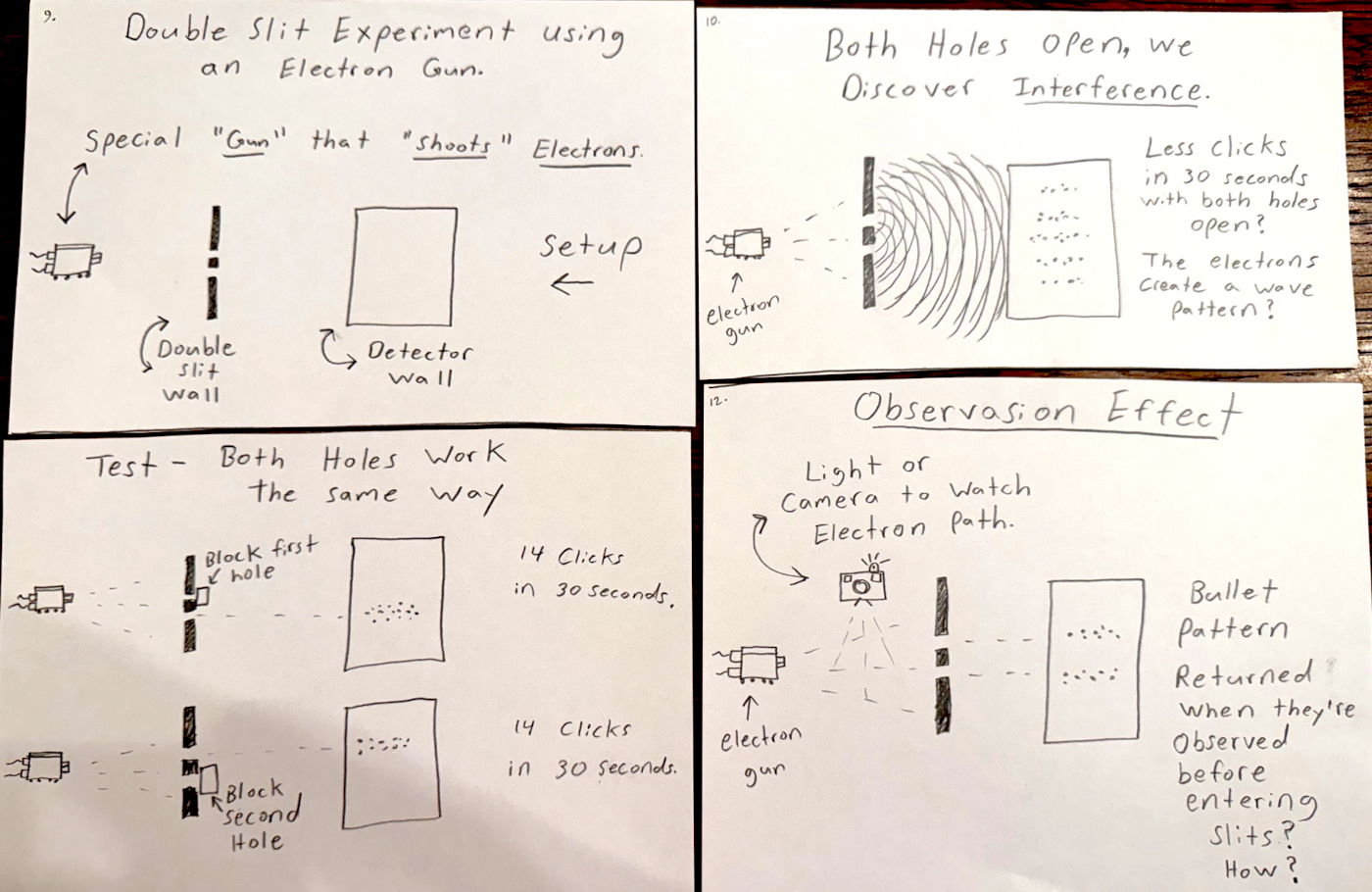
-- Our limited senses are the source of the problem. Our perception is our primary measuring tool in science, and we barely understand it. My theory helps clarify the problem. Now, let's interpret the Double Slit Experiment using the Static Matter Theory and the Principle of First Motion. Sorry if I sound repetitive, I'm trying to make this point very clear. In the static matter theory, atoms are not moving. Atomic particles are in infinite arrangements that cannot be disarranged, and they hold every possible story in reality. The only thing moving is the unseen energy that creates time, and I call it First Motion. Let's imagine the Double Slit Experiment with this new perspective. Now, what we're actually measuring on the detector wall is energy flowing along a static pathway, and the pathway is created by atoms; the atoms themselves are not moving. Only the energy is moving, and we're detecting the resistance. The resistance appears to us like a solid object. When we measure or perceive the energy, it creates an entangled point in space and time that our brains can comprehend. Once the path is seen, it cannot be unseen. First Motion energy is still flowing along all possible paths around it, but our brain can only focus on one storyline at a time. So, when setting up the Double Slit Experiment, we're creating a limited pathway to detect the flow of First Motion energy in different states.
-- To be more precise, when only one slit is open in the middle wall, we are forcing the wave-like energy to follow a singular path like a bullet. We're releasing energy from a gun that is specifically designed to shoot energy like a bullet. Thanks to the limited way we set up the experiment, we ensure it behaves like a bullet as much as possible.
-- The energy is still moving like a wave, but the hole is so small there is nothing in the immediate area to interfere with its path. Now, when two slits are open, the energy can follow more than one path, and when the paths are close together, the energy's wavelengths overlap and they interfere with each other.
-- The physical electron doesn't split and take both paths at the same time, the energy takes all possible paths available to it. The wave function is always happening. It doesn't collapse when we measure it, we're simply blocking out the energy that we can't comprehend.
-- When we attempt to measure the electron before it enters the slit, our central nervous system takes a snap-shot (or highlights a coordinate) along the energy path and we call that highlighted coordinate a particle. We cannot perceive the energy's natural state, and once we use our senses to choose a path for the energy to follow, we will continue to perceive that limited path. A measuring tool like a camera can also highlight a pathway for us to look at. A camera also behaves like a singular slit on its own to give the energy coordinates, just like our bodily senses. That's why the energy behaves like bullets when we observe it. The camera is not built to detect energy in superposition. Our senses and our measuring tools make energy look like a particle, when it isn't. Our limited perception has duality, not the particles, and that duality quantizes energy for us. So what's the mechanism that creates our perception?
-- Our perception has a dual nature because two kinds of motion activate our consciousness, First motion, which we perceive as the passage of time and we have no control over it, and secondary motion, which is the motion of our physical bodies that we can control to an extent. Secondary Motion is a filtered version of First Motion, and it's being fed back to us through our central nervous system. We're not actually seeing particles or material reality move. We're experiencing an energetic reaction.
-- Infinite solid material resists movement when it encounters First Motion energy, and that encounter creates an electromagnetic reaction, which is also gravity. What we perceive as a solid object is actually an area of higher resistance. What we perceive as a planet's gravity is a massive area of resistance. Matter wants to keep itself together despite First Motion pushing against it. Matter is dense and un-moving, even in empty space. We simply cannot perceive most of it. On a smaller scale, what we measure as the push and pull between electrons is how First Motion interacts with the framework of material reality. Remember, we perceive a tiny percentage of the multilayered reactions going on around us. If we could see all of it, it would be an infinite blinding light of pure reality. Higher temperatures is another result of First Motion encountering Static Matter. Without First Motion, the infinite universe would be sitting at absolute zero, with no energy to make it perceivable.
-- In summation, reality has three fundamental parts, a moving force that I call First Motion, infinite static material that resist movement, and an electromagnetic reaction where those forces collide. We exist within the reaction, and our central nervous systems uses the reaction to create an entangled feedback loop that keeps us conscious.
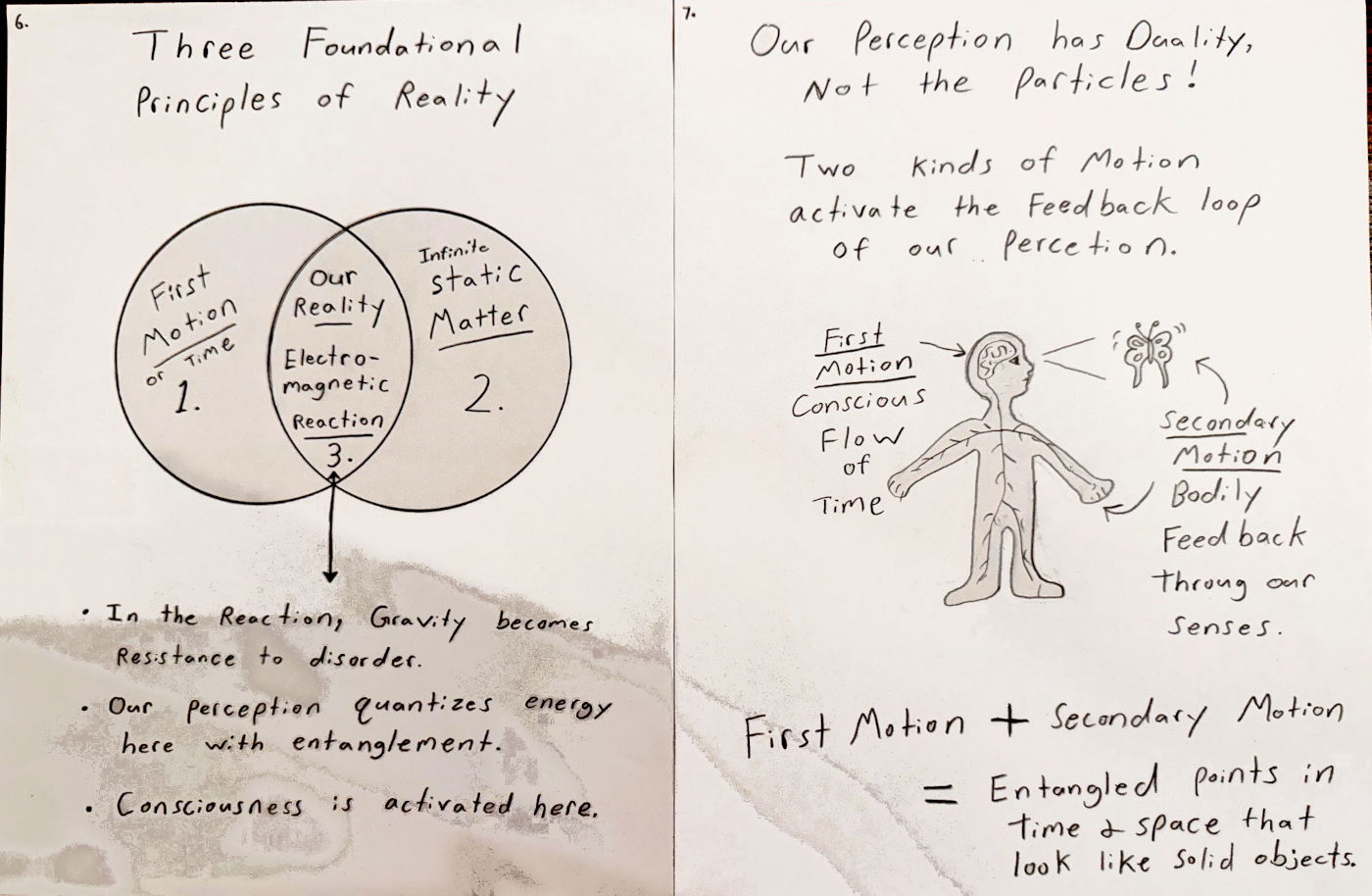
-- The feedback loop also quantizes flowing energy into something we can comprehend. Keep in mind, First Motion may not actually be moving, it's mostly a reaction between two opposing elements. Saying it moves helps us visualize how it functions in our daily lives. In conclusion, energy and mass are equivalent because they are created by the same force that creates time, and that force can help explain every problem we have in physics. Again, this new perspective doesn't change how we measure things. Everything we know about physics stills works the same way to a degree, but now we have a better explanation for why the contradictions happen.
-- All the big problems in physics are a result of the dual nature of our perception and our poor understanding of infinity. Thus, we should focus on understanding the nature of our measuring tools, which are our five bodily senses and their connection to our brain. In my next video, (or part two) I go into detail about the foundation of our knowledge, which is our perception, and I expand on how First Motion applies to everything we already know.
-- I hope you enjoyed this new perspective. If you understand my theory, whether you think its plausible or not, or if you want clarification on something, I would love to hear from you. You can contact me through my blog page, WildBlueQuantum.com, or email me directly at atomicbackstop@protonmail.com
Thanks for watching.